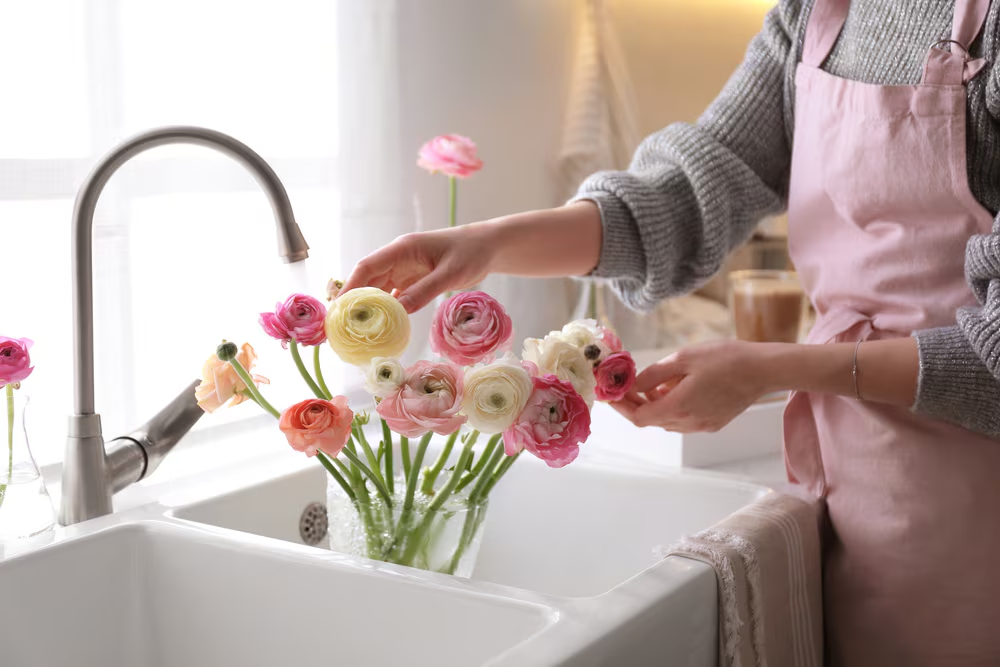How to Care for Fresh-Cut Flowers at Home
- Home
- How to Care for Fresh-Cut Flowers at Home

There’s nothing quite like the joy of fresh-cut flowers. Whether gifted by a loved one or bought for yourself, a bouquet can instantly brighten your home and lift your spirits. But without proper care, those vibrant blooms can wilt quickly. The good news? With a few simple techniques, you can extend the life of your flowers and keep them fresh and beautiful for days—sometimes even weeks.
Here’s a comprehensive step-by-step guide to help you care for fresh-cut flowers at home.
Before placing your flowers in water, wash your vase thoroughly with warm soapy water. Residual bacteria from old water or stems can cause new flowers to wilt prematurely.
Rinse well and dry.
Use a vase proportionate to the bouquet’s size—too tight causes crowding, too loose can cause drooping.
Fill the vase with room-temperature water, ideally filtered. Cold water can shock flowers, while warm water may promote bacterial growth.
Exception: Bulb flowers like tulips and daffodils prefer cold water.
Always add water before inserting the flowers to avoid air blockages in stems.
Fresh-cut stems absorb water better when cut properly:
Cut at a 45° angle to increase surface area for water absorption.
Use a sharp, clean knife or scissors to prevent crushing the stem.
Trim about 1 to 2 inches from the bottom.
Repeat every 2–3 days for maximum freshness.
Pro Tip: Cut stems under running water or submerge them while cutting to avoid air bubbles (known as embolisms) from blocking water uptake.
Leaves submerged in water will rot and breed bacteria. Always:
Strip off any foliage that will sit below the water line.
Check again after trimming stems—sometimes leaves slide lower.
This helps prevent cloudiness and unpleasant smells in the water.
Commercial bouquets often come with flower food—a mix of sugar (for energy), acidifier (to lower pH), and bleach (to kill bacteria).
If you don’t have any, you can DIY:
Homemade Flower Food Recipe:
1 teaspoon sugar
1 teaspoon lemon juice or white vinegar
A few drops of bleach
Mix in 1 quart of water
Change the water and refresh this mixture every two days.
Cut flowers last longer when they’re kept cool and away from harsh light.
Avoid placing vases in direct sunlight, near heating vents, or on top of electronics.
Keep flowers away from fruits—especially apples and bananas, which release ethylene gas that speeds up aging.
For extra longevity, refrigerate the bouquet overnight (yes, like florists do!).
Fresh water = fresh flowers.
Change the water every 2 days (or daily in hot climates).
Clean the vase with each water change.
Re-cut stems when changing water to keep them absorbing effectively.
Not all flowers are created equal—some require special care:
Tulips: Continue growing after cutting. Trim regularly and use cold water.
Hydrangeas: Soak the entire bloom in water for 30 minutes if wilting.
Daffodils: Their sap can harm other flowers—keep them in a separate vase for a few hours before combining.
Roses: Remove outer “guard petals” and re-trim if drooping.
Knowing your flowers helps you tailor their care and extend their life.
One dying flower can release mold and bacteria that accelerate the decay of the entire arrangement.
As soon as a bloom starts to wilt, remove it from the vase.
This keeps the rest of the bouquet fresh longer and visually appealing.
Mist the blooms lightly with water daily to keep petals hydrated.
Avoid drafts and fans—they dry out petals quickly.
Use a smaller, tighter vase for delicate blooms to keep them upright and supported.
Fresh-cut flowers may be temporary, but with the right care, their beauty can be enjoyed much longer. By following these simple steps, you’ll not only preserve your bouquet’s lifespan but also enhance your appreciation of each flower’s unique charm.
Flowers are living things—they thrive when nurtured. Treat them well, and they’ll reward you with days of natural elegance and joy.